|
Have a safe day!
Friday, Sept. 10
3:30 p.m.
DIRECTOR'S COFFEE BREAK - 2nd Flr X-Over
THERE WILL BE NO JOINT EXPERIMENTAL-THEORETICAL PHYSICS SEMINAR THIS WEEK
8 p.m.
Fermilab Lecture Series -- Ramsey Auditorium
Speaker: Dr. Paul Sereno, University of Chicago
Title: A Croc Odyssey: Speedy Gallopers with a Taste for Dinosaurs
Monday, Sept. 13
2:30 p.m.
Particle Astrophysics Seminar - One West
Speaker: Paolo Gondolo, University of Utah
Title: Channeling in Dark Matter Detection
3:30 p.m.
DIRECTOR'S COFFEE BREAK - 2nd Flr X-Over
4 p.m.
All Experimenters' Meeting - Curia II
Special Topic: CD R&D on Optical Links for Detector Data Transmission
Click here for NALCAL,
a weekly calendar with links to additional information.
Upcoming conferences |
|
Friday, Sept. 10
- Breakfast: Chorizo burrito
- New England clam chowder
- Carolina cheeseburger
- Tuna casserole
- Dijon meatballs over noodles
- Bistro chicken & provolone panini
- Assorted sliced pizza
- *Carved top round of beef
*Carb restricted alternative
Wilson Hall Cafe Menu
|
|
Wednesday, Sept. 15
Lunch
- Tri-colored tortellini
w/gorgonzola cream
- Sautéed spinach
- Raspberry mousse w/cookies
Thursday, Sept. 16
Dinner
- Closed
Chez Leon Menu
Call x3524 to make your reservation.
|
|
|
DUSEL planning on track
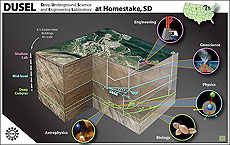 |
| A graphic summarizing the various kinds of scientific experiments that could take place in the proposed Deep Underground Science and Engineering Laboratory. |
At the first meeting of potential DUSEL users, participants and funding agencies expressed satisfaction with the progress of the design for the next proposed national laboratory and its experiments.
"Where the proposal is today is very satisfactory, and the trajectory is good," said Joseph Dehmer, director of the physics division at NSF.
If approved, construction and experiment installation could begin in 2014 and continue for seven years. A few experiments still in the R&D phase would be installed one to three years later.
The breadth of the experiments and their often one-of-a-kind nature makes DUSEL stand out, attendees said. Not only will the physics experiments put the U.S. at the head of neutrino and dark matter research, but the depth and large caverns the experiments require will allow for deep underground biology, geology and engineering research at unprecedented scales.
The suite of experiments will not be finalized for at least another year. The DUSEL Program Advisory Committee said a loosely-defined suite of experiments is specific enough to finish the facility's design but leaves flexibility for later selecting individual experiments and their designs.
So far NSF has received 25 research proposals. In general, the non-physics programs will study carbon sequestering, tunnel engineering, deep life forms and the effects of water removal and construction on seismic activity and life forms.
The proposed physics experiments break into five broad research categories: supernovae, dark matter, proton decay, neutrino mass hierarchy and neutrinoless double beta decay.
Current construction plans would allow for two simultaneous installations at the surface level. Vertical experiments such as carbon sequestering would exist from the zero to 1,700-foot level. The 4,850-foot level cavern could hold four to five physics experiments while the 7,400-foot level cavern could accommodate two physics experiments. All levels also could contain earth science experiments.
In December the preliminary design report with a revised schedule and cost will be given to NSF. DOE and NSF will receive an updated report on DUSEL science in spring 2011, and the funding agencies are expected to decide in August 2011 whether to proceed.
"We are looking forward to the next steps on this," said Heidi Schellman, DUSEL PAC member. "So, let's go."
-- Tona Kunz
|
University of Chicago's Paul Sereno gives croc talk today
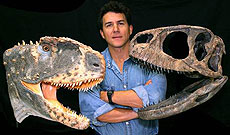 |
| Naperville native and University of Chicago professor Paul Sereno will give a lecture tonight titled "A Croc Odyssey: Speedy Gallopers with a Taste for Dinosaurs." |
Follow the expeditions that uncovered a menagerie of extinct crocodiles with Paul Sereno, who will deliver the Fermilab Lecture on Friday, Sept. 10. In his talk he will explain how these extinct African castaways and their living descendants unravel the evolutionary story.
The Naperville native and Northern Illinois University graduate earned a doctorate at Columbia University and the American Museum of Natural History and has taught paleontology and evolution at the University of Chicago since 1987.
"In paleontology, I saw an irresistible combination of travel, adventure, art, biology and geology," Sereno said.
His travels have led him from the foothills of the Andes to the heart of the Sahara desert, where his team unearthed 100 tons of dinosaur fossils and a diversity of new species. His latest discovery, a stunning human burial site dating back 10,000 years, ranks as one of the most spectacular prehistoric burials ever discovered.
Sereno is the author of books and stories in National Geographic and Natural History and has been the subject of scores of documentaries. He has won numerous awards for teaching, mentorship, and outstanding contributions to paleontology. He will give a lecture, "A Croc Odyssey: Speedy Gallopers with a Taste for Dinosaurs," is at 8 p.m. in the auditorium. Admission is $7.
Learn more
|
High-energy physics: Higgs or bust? Fermilab weighs adding three years to Tevatron run
From Science, Sept. 9, 2010
Scientists at the last remaining U.S. particle physics lab have a shot at a major discovery. But pursuing that prize means delaying other projects that could enhance the lab's long-term viability. Should they still go for the glory?
That's the question facing Pier Oddone, director of Fermi National Accelerator Laboratory (Fermilab) in Batavia, Illinois. Last week, an independent advisory committee urged him to run the lab's 25-year-old atom smasher, the Tevatron collider, for an additional 3 years through 2014. The extension would give Fermilab researchers a chance to beat their European rivals in spotting the most prized particle in physics, the Higgs boson. That chance, the panel concluded, is worth potential disruption in the schedules of other projects. Unfortunately for Oddone, however, it could also cause problems for the U.S. Department of Energy (DOE), which funds the lab, and jeopardize the lab's future.
The Higgs boson is the lynchpin to physicists' explanation of how all particles get their mass. And Fermilab researchers have a chance to see it first because the more-powerful Large Hadron Collider (LHC) at the European particle physics laboratory, CERN, near Geneva, Switzerland, is running years behind schedule. In February, CERN announced that the collider will shut down for extensive repairs for at least 15 months beginning in 2012. At that point, the LHC won't have produced enough data to surpass the Tevatron in the race for the Higgs.
Read more (subscription required)
|
|
|
Into the unknown
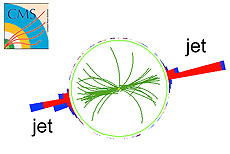 |
| This figure represents a collision recorded by CMS with 2.136 TeV of energy. The Tevatron's maximum energy is 1.96 TeV. Figure adapted from here. |
We hope the LHC will one day discover phenomena that totally change the way we look at the universe. However, the amount of data collected thus far by the LHC experiments is very small compared to that recorded by the Tevatron experiments. We expect that it will take a while for the LHC experiments to unlock their full potential.
On the other hand, there are some things that the LHC can do with the first data that are impossible at any other facility. One such thing is to study particle collisions with an energy higher than the Tevatron's beam energy of 1.96 TeV.
Protons and antiprotons are actually composite objects, composed of even smaller particles called quarks and gluons. A good analogy might be a bean bag, with the proton as the bean bag and the quarks and gluons as the beans. At both the Tevatron and the LHC, the thing of interest is a collision between a single bean from each of two bean bags. Because there are many beans, each carrying some of the particle's energy, these collisions involve less energy than the accelerator gives to the beam particles. Thus, it is essentially impossible for scientists to see a two-bean (or quark) collision at 7 TeV at the LHC and a 2 TeV collision at the Tevatron.
The LHC has already seen many two-quark collisions with energies higher than the maximum possible at the Tevatron. Readers will recall that experimenters observe not individual quarks but rather jets, which are sprays of particles all going more-or-less in the same direction as the scattered quark. The Standard Model predicts that the quarks are usually scattered at small angles compared to the beam. Today's Result of the Month reports on a recent study of collisions in which the quarks are scattered at angles closer to 90 degrees from the beam direction. This sweet spot is where physicists expect to most easily find new physical phenomena.
So far, we have observed nothing new. However, this and similar studies are already ruling out phenomena beyond what the Tevatron can see. As more data comes in, the CMS experiment will continue to push forward into the unknown and, we hope, make a discovery.
- Don Lincoln
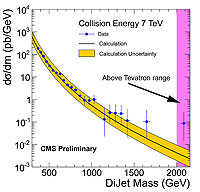 |
| This data plot shows the amount of energy involved in a collision between the quarks in two beam particles. This data restricts itself to collisions occurring at angles near 90 degrees to the beam direction. We can relax that criterion and routinely observe even higher energies, although such a choice would reduce CMS' sensitivity in our searches for new physical phenomena. Figure adapted from here. |
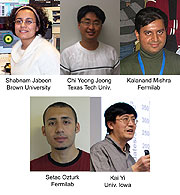 |
| These junior physicists have played pivotal roles in this exciting new result. |
|
Birth
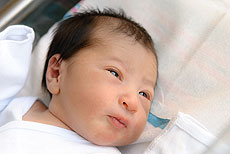 |
| Case Western Reserve University physicist Karen Gibson and her husband, Ryuji Kusumoto, welcomed a son, Henry Francis Gibson, into the world at 12:14 a.m. on Aug. 27. Henry weighed 6 pounds and 7 ounces at birth. Congratulations! |
|
Did you make a difference? Share sustainability stories
Fermilab is putting together a sustainability website and is looking for stories from employees and users about how you help the environment at work. Please tell us your story!
Maybe you ride your bike to work every day, recycled material for a project or thought of a new way to reduce energy use at the laboratory.
What actions or steps have you taken at work or in getting to work that reduce waste, prevent pollution or otherwise lessen your impact or the laboratory's impact on the environment? Please e-mail your story to kswanson@fnal.gov. |
|